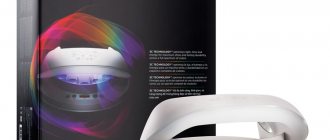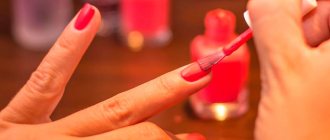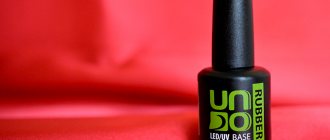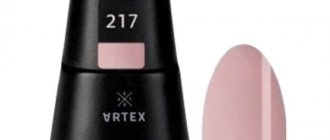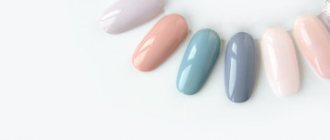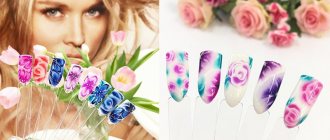Every manicurist who has been working for quite a long time, as a rule, has a whole cemetery of all kinds of nail lamps.
And although some of them are in working condition, they are no longer going to use them.
If you are just a beginner, how can you avoid all these mistakes when choosing and buy a truly working option that will serve for a long time and properly?
Let's look at all these nuances in more detail and help you make the right choice.
Types of lamps for manicure
Today technology has come quite far. Modern models have significantly changed both their appearance and functionality.
The most common are five types of lamps for drying manicures:
- ultraviolet (UV) – luminescent
- LED lamps
- CCFL with cold cathode coil

- hybrid – CCFL+UV
- hybrid LED - UV/LED
Tools for manicure using shellac
Applying shellac is not such an easy procedure. To perform it well, you will need a decent list of tools and special substances. Substances include:
- Degreaser;
- Base for applying shellac;
- Selected shellac color;
- A product to cover the finished result.
Tools include:
- Standard manicure set;
- Various set of nail files;
- Collection of brushes;
- Special lamp for drying.
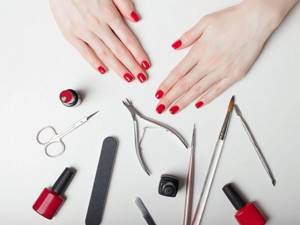
And if the tools can be replaced with improvised means, and the substances for performing a manicure can be bought as a set, then without a lamp for drying shellac it is impossible to complete the procedure. Without it, it simply will not dry and will look like thickened jelly on the nails.
Differences between CCFL, Led, UV and hybrid
Although they are different, they all emit ultraviolet light.
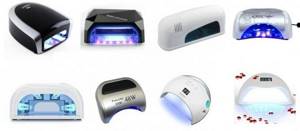
The main difference is with what intensity and what wavelength they do this.
Light in general is a very interesting thing. And many things that seemed an axiom to us in school can be quite surprising in adulthood.

The first two types of lamps are more or less clear. They use well-known fluorescent and LED light bulbs.
What is CCFL? In CCFL models, as a rule, there is one spiral-shaped cold cathode lamp, without an incandescent filament.
Its upper location does not always allow uniform polymerization. Often, the spiral does not dry UV gels well on the sides of the arched fingers.
CCFL+Led combines two technologies at once. Here we already have a hybrid lamp. But we’ll talk more about this a little later.

Hybrid UV/LED are assembled entirely using LEDs, but with different emission spectra.
1 of 2

What is the fundamental difference between UV and LED bulbs? To understand this, take a look at the image below.

Here is the range of radiation and the difference in intensity and wavelength of these types. UV lamps have a wavelength from 280 to 400 nm. The ice is much shorter.
It turns out that ultraviolet lamps cover the entire range from mark 1 to mark 2 (see figure), but diode lamps do not.
A simple rule follows from this: if some material dries well in LED copies, then it will dry 100% in ultraviolet copies as well.
When this does not happen, look for an explanation in insufficient UV power or in a bulb that has lost its properties.
Why do we need these lamps?
Well, the courses on nail coating have been completed, and a certificate as a manicurist and pedicurist has been received. If the training was carried out using the teacher’s equipment, then you may find yourself at a crossroads - what power is the lamp needed, what manufacturer, will it be used only at home or is it worth starting to make money in this industry? There are many questions, but the main one is: which one is better to choose for the starting step?
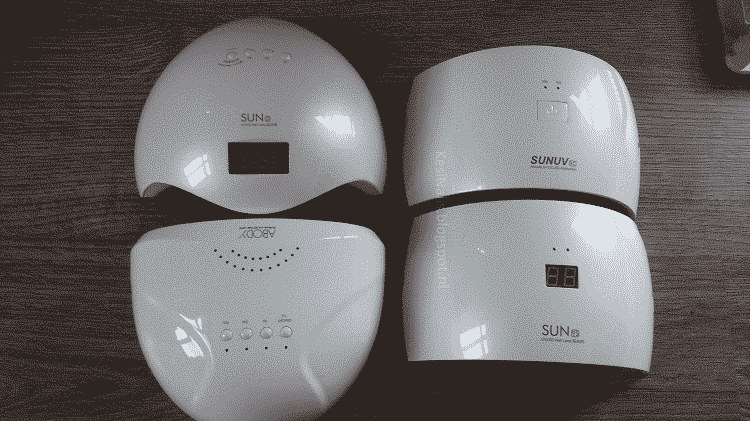
All existing lamps have one thing in common - they all emit ultraviolet radiation. Only the method of its emission, wavelength and spectrum of action are different.
To create the correct nail shape, nail industry masters use extension gels. Less often - acrylic. In order for the material to harden and become a “nail”, you need a lamp with ultraviolet radiation of the desired wavelength. Such devices include UV lamps with fluorescent lamps.
Gel polish coating also requires drying. Gels that have been developed recently harden under LED lamps. Polymerization can last for different times, and it depends on the power of the device.
New to the industry are CCFL devices. They are able to emit ultraviolet light in a different way - using cold cathodes (tubes filled with gas).
Universal devices can also be found in the professional accessories market. They are combined devices (hybrids). They operate on the basis of both LEDs and fluorescent light sources.
Lamp – hybrid
The operating principle of the lamps is different, but they all have the goal of polymerizing the gel. How long to keep your nails in each of them depends on its type.
What varnishes and gels dry different models

Inexpensive UV models with power up to 36W can cope with the following material:
- any gels, including LED
- biogels
- gel polishes
Less powerful ones can only work comfortably with transparent coatings. For example, finishing with gels.

Why do we need LED models if UV copes with such a wide range? Due to the longer wavelength in UV specimens, polymerization occurs gradually and takes much longer.

Even gel polishes dry in them in up to two minutes. They will also delay the hardening of the material.
That is, between the time you place your hand inside the device and the time when the gel polish stops spreading and somehow fixes, 20-30 seconds pass.
It is during this period that problems arise.

And in ice lamps everything happens in a matter of seconds. No matter how large the drop is.
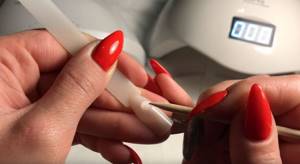
That’s why professionals recommend diode models for beginners, although they are more expensive. But at least you will make fewer mistakes with them.
LED manicure lamps polymerize:
- gel polishes
- some biogels
- expensive LED gels
Well, in general, always be guided directly by the inscriptions on the bottles:
- LED – can be dried in LED or hybrid lamps
- UV/Led – universal material for all types

- UV only – dry in UV fluorescent, CCFL or hybrid
When there are no inscriptions at all, then apply as for UV. Now let's finish with the theory and move on to specific examples and brands.
Ultraviolet lamp for manicure
Before purchasing a particular brand, ask yourself the question: for what purpose will you use the lamp?
If you are not yet a professional craftsman making money from this, but just want to apply gel polish yourself at home, then there is little point in buying an expensive branded LED hybrid lamp.
Take a closer look at UV options. The very first models for home use were 9-watt UV lamps of a similar design.

They have only one light bulb inside the housing. To be honest, it doesn't make much sense. The only thing it can dry is a transparent single-phase gel, which is very liquid in consistency.
There is no way to polymerize white, colored, or pigmented gels in it. Therefore, despite the attractive low cost, today professionals do not recommend buying such a lamp in principle.

Even for infrequent home use.
Also immediately discard any pocket or USB models. They are only suitable for fixing some small design elements.

But under no circumstances use them for full-time work. They simply do not have the power required to dry the entire coating.
As a result, you will get a negative result, and the varnish coating will not have shine and will not last long.
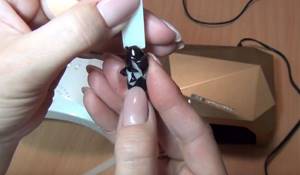
Meanwhile, with sufficient power and the right shutter speed, you can get a very beautiful result.
Advantages of the equipment
Reviews from other users will help you choose high-quality table lamps for manicure. It is better if such a device is attached to the side surface of the desktop. This will allow you to leave more space under the work surface.
Let's go over the advantages of lamps for manicure:
- Compactness.
- Small price.
- Durable design and robust housing.
- Precise direction of light that can be changed.
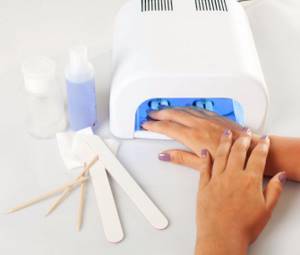
There are also manicure lamps with a drying effect.
- They don't flicker or get hot.
- A movable tripod allows you to adjust the height and angle of the lamp.
Advice! The use of energy-saving lamps allows for 8 thousand hours of operation without interruption.
What power and drying time is needed?
The minimum power required from a UV lamp is 36W. As a rule, the housings of such powerful specimens contain not one, but 4 light bulbs.

With this type you can polymerize absolutely any varnish that is on the market today.
Their main disadvantage is that drying takes a long time. This is usually a minimum of two minutes for colored gel polishes.
Even cheap LED ones take about 30 seconds.
Replacing UV Bulbs
Another disadvantage of ultraviolet lights is the frequent failure of the bulbs themselves. If you use it no more than once a week, then it will last you for a couple of years.
With constant work (5-6 clients per day), you will have to change the light bulbs every 3 months.
They are easy to change. Simply pull the old one out of the housing by the body and stick the new one in its place.

It would seem that this is not a big problem at all. One burned out, replaced with another. They are not that expensive - from 100 to 150 rubles.
The trouble is that when it fails, it is not entirely noticeable. The lamp will still emit violet-green light, but it will have virtually no UV intensity required.

As a result, the varnish will begin to shrink and dry poorly. If such symptoms appeared on a previously working lamp, remember how long ago you changed the light sources in it.
That is why experienced manicurists try to immediately write down the date of installation of the lamps, and if they work frequently, they change the set approximately every 3-4 months.
When you have to change all the lamps several times throughout the year, you end up wondering whether it was worth spending all that money on something better in the first place?

And don't forget that the light bulbs here contain mercury. And if you accidentally dropped it and broke it, then the process of demercurization of the room cannot be avoided.

Therefore, if you are willing to spend more, in this case, choose LED UV/Led lamps with a power of 36W.
Basic parameter
The polymerization time is determined by the power. It determines the degree of heating of the working elements. The power of gel polish lamps varies from 9 to 90 W.
“Low-power” models cope with their task just as well as their stronger counterparts. However, they will need more time to achieve their goal. In conditions of work with an intense flow of visitors, this is unacceptable.
In addition, many women choose several layers of coverage. It may not only not dry out, but also “shrink” from heating for too long. There is only one way out - use a lamp with high power. The same applies to pigmented varnishes, which also require careful drying.
But it would be unreasonable to write off devices with low power. In this product segment, you can choose a compact sample that will be useful on a long trip. It is also suitable for those craftsmen who provide service at home. When working with it, it is important to remember: you cannot apply a thick layer of overly complex or pigmented decor to the nail plate.
Approximate time intervals for different types of equipment:
- 3 minutes - 9 W.
- 2.5 minutes - 18 W.
- 1.5 minutes - 36 W.
So, for a nail artist, the question of how many watts should be in a manicure lamp is fundamental. After all, for him literally time is money. The more clients he serves, the higher his real profit will be. Therefore, professionals value devices with higher power.
It is possible to reduce the listening period to 60 or even 40 seconds in a salon with a large number of visitors. For this purpose, workplaces are equipped with devices with power ranging from 36 and 48 to 90 W. For home use, such power is not justified.
LED UV/Led lamps for nails
Low-power and miniature models can only be considered as a travel option for long trips on vacation. They have very small lighting angles and not all fingers can be dried equally well.

You will have to constantly twist your palm and look for a more or less comfortable position to grab the little finger.
The undisputed leader in sales among high-power UV/LED lamps is the SUN brand.
They have a great variety of models. And even masters sometimes get confused in the assortment.

According to the manufacturers, the LEDs here last up to 50 thousand hours during continuous operation.
However, these indicators should be treated with some skepticism.
As practice has shown, such a duration can be achieved only in two cases:
- economical operation with long cooling breaks
- modernization and integration of additional fans into the case
Without these conditions, your vaunted SUN lamps will last on average about 6 months.
Some tips for choosing a lamp
- Focus on the number of clients . This factor becomes decisive in terms of the power of the device. The higher the power rating, the faster the polymerization of the coating occurs. High drying speed affects the average procedure time and the number of clients per working day;
- Take a closer look at brands that produce manicure products . Their devices are designed taking into account the specifics of the work - they are equipped with touch controls, a timer and have a more durable design;
- Availability of additional functions . At first glance, it seems that their presence is not necessary, but in fact they simplify the work of the master. The touch sensor will help you not to be distracted by starting the timer, and the built-in battery is not replaceable during frequent visits to clients, where the outlet may be inconveniently located;
- For professional use, purchase devices with a warranty of at least 6 months , this will protect you from possible manufacturing defects and save you from additional expenses.
LED lamp - characteristics and how to use it correctly
SUN 5 lamp and others - comparison
One of the most popular models of UV/Led lamps is SUN 5 with a power of 48W.
It has an unusual capsule shape and four timers for 10-30-60-99 seconds.
The bottom is removable, with magnets. This is a great help for cleaning dirt and minor repairs.

Also, options with a removable bottom or without it at all on other varieties allow you to use them for pedicures.
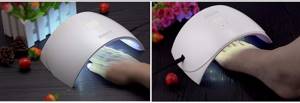
Inside, in addition to LEDs, there are ventilation holes. True, there is no built-in fan.
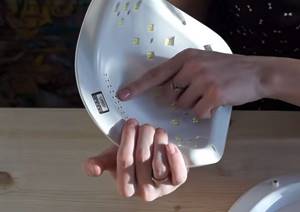
But Sun One has it.
Many people are mistaken in thinking that it is necessary to air out the fingers and prevent the unpleasant burning sensation on the nails. The fan in powerful lamps primarily performs the task of cooling the LEDs. No more.
The lamps from this manufacturer are powerful and bright.

Almost everything is dried - extension gels, shellac, ice gels.
Many manicurists praise it without pointing out its shortcomings. And they also exist.
Flaws
What are these disadvantages? Firstly, the SUN 5 does not have a reflective surface on the bottom cover.
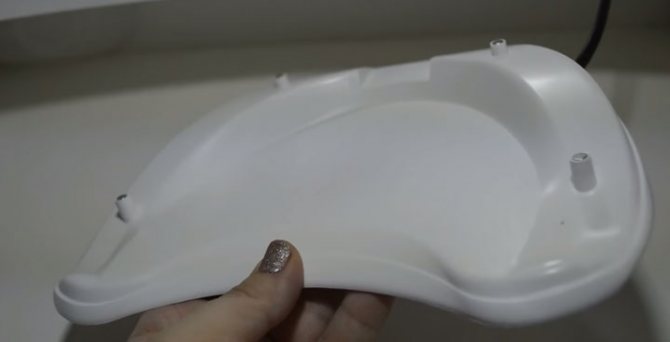
This means that with mirror correction, the nails underneath will not dry immediately. You will have to turn your palm over again and go through another drying process.
But the most important drawback is the large dead zone, almost class=”aligncenter” width=”720″ height=”481″[/img]
Not all clients put their hand far into the lamp.
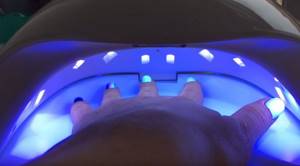
And if at the same time the nails fall into this “dead zone,” then big problems arise. Especially with modeling gels.
Also check the tightness of the lid at the bottom. They often have large gaps.
What does this mean? Since the light breaks through, nothing should be placed next to the lamp. Otherwise, the brush or materials may polymerize randomly.
True, some people consider additional holes to be a good thing. They supposedly help prevent the LEDs from overheating and provide greater cooling. However, this is not the case.
It is not recommended to work with such a lamp for more than 2 minutes. For long corrections they are far from an ideal option. Moreover, they do not have a built-in fan.
Some craftsmen drill additional holes in the case and mount their own fan, just like on computer processors.
But even with such modernization, the heating temperature of the LEDs doubles in just a couple of minutes of illumination. From room temperature 20 degrees it instantly rises to 40!
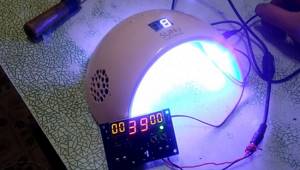
What happens without forced airflow and only natural cooling? In this case, even the plastic begins to heat up and deform.

Also keep in mind that when overheated, the emitted ultraviolet spectrum may shift to longer wavelengths.
What does this mean for the client and for you? And the fact that some gel will begin to dry out worse than with a “cold” lamp.

It turns out that the first clients will leave satisfied, but the subsequent ones will not like the result of your work at all. At the same time, you will never understand what this is connected with. It seems that the gel is the same, and the lamp is the same, but the result is different.
After this, reviews appear on the forums that Sun lamps for manicure are not reliable and often burn out.
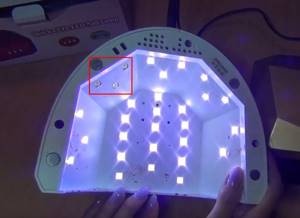
On AliExpress there are, of course, replacement diodes, but they are sold as a set and cost from 2 thousand rubles.
It is best to work with such lamps in 4-4-2 mode. That is, dry 4 fingers and let the lamp cool as much as possible while the other four are painted.
And only then move on to your thumbs.
Also, Chinese models do not always correspond to the declared power of 48W.
If you connect such a lamp not directly to a socket, but through a special wattmeter, you will be unpleasantly surprised.

Actual figures may differ by almost twice!
1 of 2

Those who actually faced all these problems gradually began to choose and try other models.
Here, for your convenience, is a comparative table of characteristics, advantages and disadvantages of the most popular manicure lamps produced under the SUN brand.
Here are SunOne, Sun5, Sun9s, Sun 9c plus:
Varieties by light source
The table lamp for manicure is quite simple. It consists of a housing with a built-in lamp and a control panel. The lamps used can be fluorescent, LED and conventional (incandescent). Let's briefly look at their pros and cons.
- Lamp with incandescent lamp. As a rule, it is the most affordable. But its lamp has a short service life, gets very hot and produces a dim yellow light beam that tires the eyesight.
- A lamp with a fluorescent (popularly called simply energy-saving) lamp. Manufacturers produce models with different powers and three types of glow - yellow, neutral and cold. A fluorescent lamp saves energy, lasts a long time, does not strain the eyes too much, but costs about 4 times more than a regular lamp.
- LED lamp. Currently, LED options are considered the best, since they do not heat up at all, are compact in size and can produce a bright luminous flux of any color temperature. One of the features that needs to be highlighted is the ability to adjust the color temperature in some models. High cost could be considered a disadvantage, but LEDs are completely safe, have a very long service life, consume little electricity and ultimately turn out to be more financially profitable.
Hybrid CCFL+UV lamp
However, speed is speed, but no less worthy results are shown by the so-called hybrid CCFL + UV lamps for nails.
They combine ultraviolet and diode light. Co-glow is useful when drying any capricious material.
Among the popular hybrid models is the Diamond 36W Led+CCFL. It is also called Diamond Stone Diamond.

It costs around one and a half thousand rubles. It has a compact shape and touch sensors. The timer here is for 10-30-60 seconds.
The bottom of the latest models is removable and magnetic.

36 watts consist of a 12W UV cold cathode coil and 24W LED diodes.
Below is a visual comparison on nail tips, drying capricious BMG gel polish in two different models.

We dried it in regular UV for 2 minutes and got the following result.
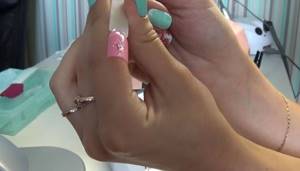
And in this hybrid Diamond it’s only 30 seconds.

In a hybrid, the varnish is completely dry and does not smudge. And in the ultraviolet there was shrinkage. There is nothing worse than dry polish.
Advantages of this hybrid option:
- average price category
- fast drying time
- compact size
But do not forget the disadvantages of CCFL - the upper location of the spiral and poor lateral drying of curved fingers. Service life and periodic replacement of lamps.
Hybrid models
This type of lighting device combines several types of lamps. The building contains:
- Ugh;
- LED;
- CCFL.
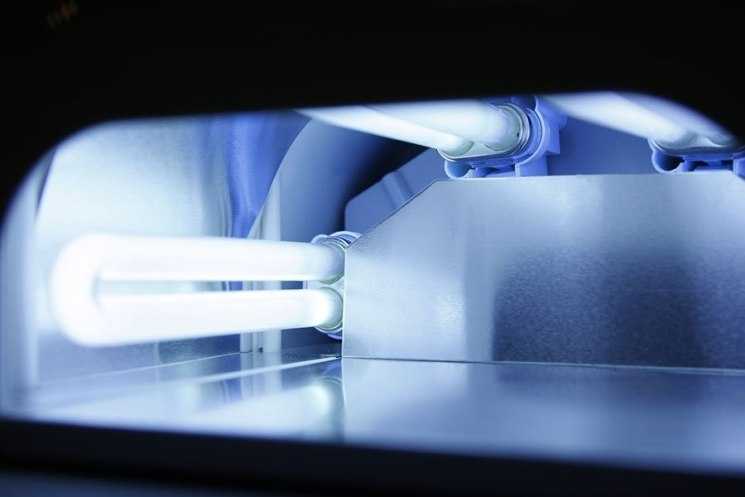
Particularly popular are models that combine 2 types of light sources. They combine LED and CCFL lamps. Polymerization occurs already at 10 seconds. The coating is dense and reliable.
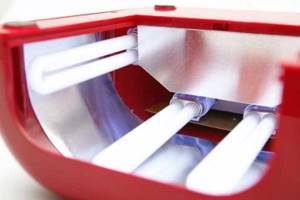
The cost of such products varies depending on the types of light points. Budget options combine LED and UV lamps.
When heated, they promote a rapid chemical reaction during which polymers and acrylates combine.

When heated, they emit a bright purple glow and a small amount of heat. Before using such a device, it is necessary to take into account the individual characteristics of the human body.

Prolonged exposure to a hybrid lamp may cause an allergic reaction. As a result, the client will experience a burning sensation and discomfort on the skin of the hands.
Which ones to choose
To summarize, we can draw the following conclusions. If you are looking for a lamp just for yourself and don’t want to waste extra money, then a UV lamp with a power of at least 36W will be quite enough for you.

If you are willing to spend a little more, then CCFL+UV hybrids with the same power of 36W are a decent option.
Well, when you want to become a master and work professionally with gel polishes, then your choice should look towards UV LED lamps from 48W with many functions and modes.
Advantages of shellac nail extensions
A manicure done independently guarantees protection against infections and poorly processed tools by the master. In addition, this is an opportunity to get a manicure without being tied to a specialist and in your free time. And developing your own nail design and bringing it to life is a manifestation of creativity and imagination.
If you get the hang of it, the procedure for nail extensions with shellac will not take much time. Of course, applying shellac will require more diligence than a regular manicure, but this procedure will allow you to have well-groomed hands for a period of 3 to 4 weeks, freely go to the pool and wash dishes.
In addition, nail extensions can bring a good income, provided that the procedure is followed correctly, high-quality equipment and close friends. However, reaching a professional level does not require the use of all types of devices, that is, compact models with an extended layer curing period will have to be left in the past and choose a powerful professional lamp. Fortunately, the market for shellac drying lamps today offers a wide selection of units that differ in drying principle, power, dimensions and design. The choice is yours!



